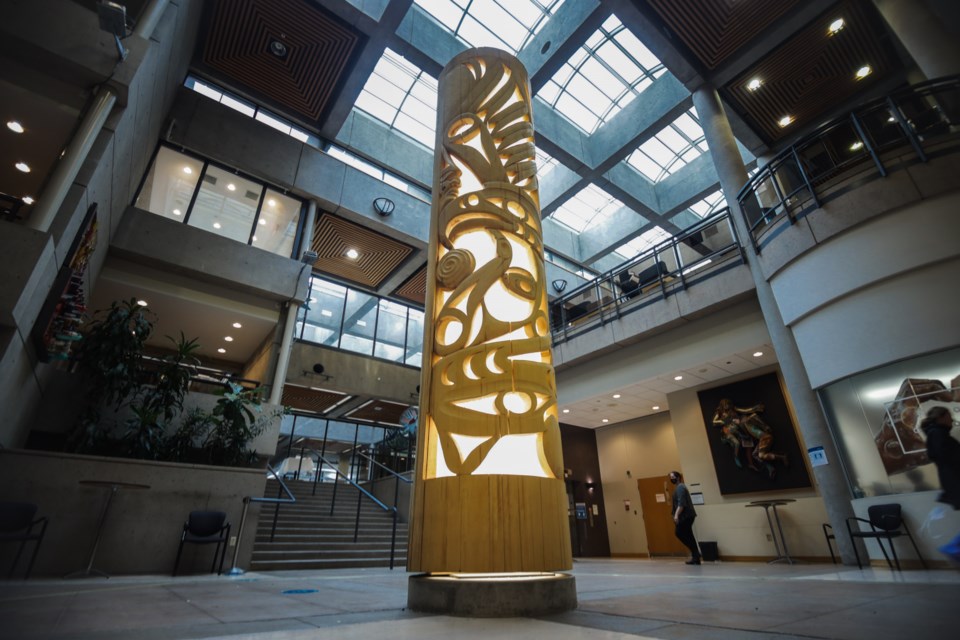Three First Nations house posts now stand tall at Vancouver General Hospital, representing the nations on whose unceded and traditional territories the hospital sits.
The traditionally carved house posts can be found in the Diamond Family Courtyard in the Jim Pattison Pavilion and represent the xʷməθkʷəy̓əm (Musqueam), Sḵwx̱wú7mesh (Squamish) and Səlilwətaɬ (Tsleil-Waututh) Nations.
The house posts were officially raised on Dec. 11 after a public blessing ceremony at the hospital, “marking an important step in the journey toward reconciliation.”
“For far too long, First Nations have been invisible in our own lands,” said Chief Ian Campbell of Squamish Nation.
“These three house posts will serve as a visible reminder that First Nations have strong ties to these lands and have been here for thousands of years.
“It's time to celebrate that our history is your history, and we can stand together in strength today."
Vivian Eliopoulos, interim CEO at VCH, said the house posts would be an everyday reminder of VCH’s deep commitment to improving the care and health experiences of all Indigenous people in the region.
“This is an important piece of our larger journey toward reconciliation,” she said.
“In light of the revelations from the In Plain Sight report, we humbly recognize we still have a long way to go.”
Vancouver Coastal Health, with the support of VGH and UBC Hospital Foundation, has been working with the Knowledge Keepers of the three host nations to transform the courtyard into “a healing gathering space that recognizes the link between the hospital and Indigenous people in VCH’s care,” according to a VCH release.
Each house post was created and designed by a local carver from each of the three Nations: Brent Sparrow Jr. of the Musqueam Indian Band, Xwalacktun of the Squamish Nation and Zac George of the Tsleil-Waututh Nation. pic.twitter.com/9cb8LRSZfJ
— Vancouver Coastal Health (@VCHhealthcare) December 11, 2020
The year-long project began in fall 2019 with the acquisition of three yellow cedar logs by Squamish Nation. Each house post was created and designed by a local carver from each of the three nations, and they all share messages of health and well-being in different ways.
The Squamish Nation house post was carved by Xwalacktun, Rick Harry, who has been carving for more than 20 years, and tells the story of Xwech'taal, a Squamish hero who slew a serpent and earned the ability to heal others.
“The pole depicts overcoming things that challenge us, whether it be ailments of the mental, physical, spiritual, or emotional dimension,” a VCH release explained.
The Musqueam Indian Band house post, carved by Brent Sparrow Jr., has an eagle at the top, which symbolizes Musqueam ancestors and loved ones as guardians watching over patients while providing them comfort and protection through recovery.
Tsleil-Waututh Nation artist Zac George carved the final post. The Salish house post titled Qut'same honours the legacy of the late Chief Leonard George.
“Leonard had a deep passion for Indigenous health and endeavoured to bridge the gap between his people and the health-care system,” a VCH release stated.
“The house post design shows Qut'same standing in a Salish woven basket, holding a salmon and sharing it as a gift to welcome people to the territory where Vancouver General Hospital is located.”
The house post-installation is the first phase in a redesign of the Diamond Family Courtyard.
As part of its efforts to improve the health experiences of all Indigenous people in the region, VCH has also been working in partnership with First Nations Health Authority to advance cultural safety and humility. The Aboriginal Health team has implemented a strong foundation of programs and services, including an Indigenous Cultural Safety training program that has been completed by more than 3,300 VCH staff over the past four years.
Elisia Seeber is the North Shore News’ Indigenous and civic affairs reporter. This reporting beat is made possible by the Local Journalism Initiative.



